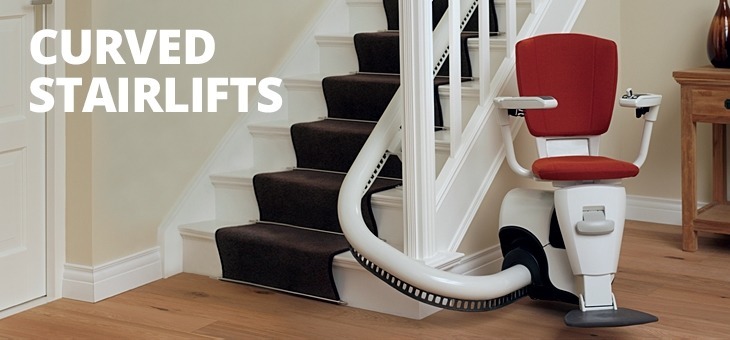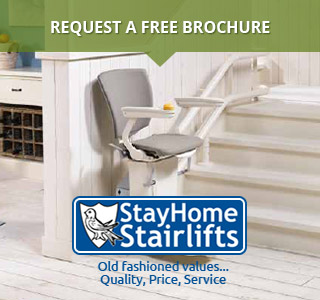
Curved Stairlifts
Curved stairlifts can travel around corners and so is suitable for staircases that arc or bend. The curved rail system manoeuvres smoothly around staircase curvatures and can even be made to run onto a landing, making it ideal in houses that have several levels.
What is a Curved Stairlift?
A curved twin rail track can be fitted on either side of the stairs; the layout of the staircase will determine which side is the most suitable, although most run on rails on the wall side of the stairs. Seats often have folding arms and footrests to take up less room when not in use. Tracks can be designed and made to suit any stair layout, including quarter landing, fan, half landing and spiral, and can take users securely and safely up several flights of stairs, if required, with no pause between the different levels.
How do They Work?
Due to variations in shape and size, curved staircases are factory built before installation and require customisation to ensure a perfect fit. They can be designed to run on the most complex of staircases. The speed at which a stairlift travels is governed by British Safety Standards, which rules that they need to move no faster than a gentle, walking pace and have a smooth start and stop mechanism.
Safety is a paramount consideration, and there will be automatic cut-out mechanisms to ensure that the lift will not operate unless the user is securely strapped in, and there are no obstacles in the way. The lift can be controlled by the user and summoned to the top or bottom of the rails, using a remote-control handset.
While straight stairlifts are usually mains-powered, most curved stairlifts are battery-powered. This is to avoid problems that might arise from a power outage during use, and charge points are incorporated into the rails at the top or bottom. A curved stairlift will include a self-levelling mechanism, to balance the chair as it travels around any turns or twists and slow it down to reduce wear and tear.
The Costs Involved
The costs of customisation and often complex installation make curved staircases more expensive than straight stairlifts. More technical work is required, and the more curves, arcs or bends in the staircase, the more expensive it will be. Labour costs will also be higher, as it usually takes half a day or more to fit, rather than the two or three hours needed to fit a straight stairlift.
If a property has an in-line or flat-bend intermediate landing, it may be more cost-effective and simpler to install two straight stairlifts rather than a curved one, but the user would need to be able to get from one lift to the other, which is not always possible.
A curved stairlift makes ascending several floors seamless and easy. People sometimes try to save money by installing a straight stairlift on part of a curved staircase if there are only one or two steps left at the top of bottom, but they need to consider whether they will always be able to cope with even a few steps; covering an entire staircase using a curved track is a safer option.
Installation of a Curved Stairlift
A survey is required on each individual staircase, before the track is manufactured to order. A complicated specification can take several weeks to produce. The surveyor will not only measure the dimensions of a house and its staircases but will assess the ease with which a user can get on and off the stairlift. It is also a good idea to get the advice of an Occupational Therapist before choosing a stairlift, as they can give guidance on the best and most comfortable style of seating to choose for individual needs.
Most standard stairlifts will carry a user of up to 120kg, but heavy-duty stairlifts can be made for people who are heavier. If there are obstacles near the staircase, such as radiators, banister rails, doors and thresholds, a hinged track can be installed. This allows the track to be folded away when not in use to give clear access. The hinging mechanism can be manually raised and lowered, or an automatic powered hinge can be operated using a button on the remote control.
A curved stairlift can also be installed to run for some way onto the landing, rather than stopping at the top of the stairs. Modern stairlifts are designed to be unobtrusive, and fit close to the wall with slim rails, to give independence without making major structural changes to a house.
Stairlift Maintenance
Once installed, all stairlifts, whether straight or curved, need regular maintenance to ensure they are in good working order. Servicing should be carried out at least every twelve months by a fully qualified engineer. Many companies give warranty cover which includes free annual servicing, and also offer a 24-hour emergency call out service. Buyers should ensure that they purchase from a company that guarantees a quick response time. Many modern stairlifts include digital displays that will warn of any potential problems
The StayHome Promise to You
- Be open seven days a week 9am – 9pm
- Give you simple, open and honest advice
- Not pester you with unwanted calls
- Recommend the best stairlift for your needs
- Give prices over the telephone so you know what to expect without a survey
- Behave in a professional, caring and respectful manner
- Make appointments at your convenience
- Never put you under pressure to buy
- Install your stairlift without mess or disruption
- Provide a clear quotation




